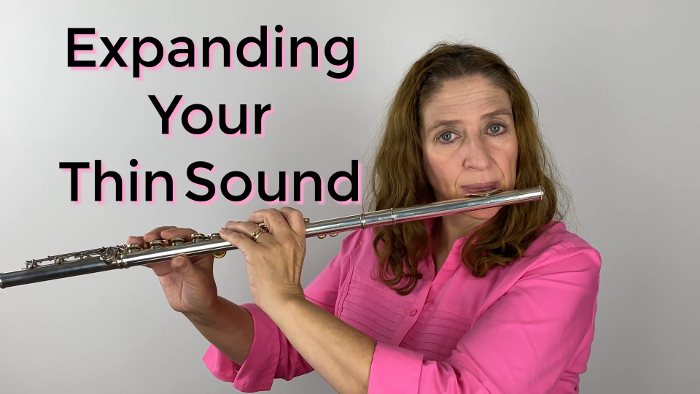Do you have trouble trying to make your tone bigger? Would you describe your tone as thin and small or tight? You tone doesn’t have to be that way forever. There is help.
You are not alone in both the desire for a richer more resonant tone nor in the desire to change your tone. Many flutists want a tone that makes people stand up and take notice. The good news is that you can have that tone. Your tone can expand with some careful work and attention. It can become rich and powerful. But you have to do some work to get your tone to that level. It all comes down to breathing and embouchure. When you work on these areas your tone can become all you wish it could be.
Tight Throat
There are a couple reasons why a sound is thin. One of the first ones is a tight, tight throat. Now, a throat can be tight and the embouchure can still be relaxed. If the throat is tight, you can still make a sound. But the throat will affect the result. I can always tell when a student has a tight throat because I can hear their breath. The breath is a gasp that is very audible. This is a telltale sign that the throat is tight.
Fixing this isn’t a large problem it just takes thinking about it every time you breath. When you take that breath, it needs to be a yawning breath. Take a moment to yawn. Feel what the throat is like when you yawn. The throat is very open almost as if you could fit a lemon down it. By yawning, you not only open the throat going down but you open it going up to your sinuses. The sinuses are where your resonant tone comes from. That is what gives you that phenomenal sound. One flutist that demonstrates this resonant tone very well is Denis Bouriakov. If you haven’t listened to him yet, go to YouTube and take a listen. His tone is one to emulate. He has a great resonant sound. You can tell that it’s moving around in the sinuses and that his throat is nice and open.
Tight Embouchure
Another reason for a tight sound is a tight embouchure. A tight embouchure makes the opening very small. If my embouchure hole is too tiny, my sound is going to be tiny. A tiny sound is a thin sound.
You’ll know if you play with a tight embouchure by looking in the mirror while you play. Look at the size of your embouchure opening. Is it very small?
Another sign that you have a tight embouchure is that after playing for a while, you feel like your cheeks are so tired that you want to massage them, or you just need to take a break from playing.
I never, ever, ever, ever, ever get tired playing. At least from this perspective. My arms get tired, and sometimes I get weary. But my embouchure never, ever, ever gets tired. That’s because my embouchure is very relaxed.
Tight Teeth
The third reason to help with a bigger tone is to open the teeth. If your inside of your mouth is closed, the only thing that’s going to come out is a closed and thin sound. I’m a big proponent of talking about teeth spacing and making sure that you have a lot of space between your teeth, because that opens up the inside of your mouth which in turn lets your sound out to be big and luscious.
In the low register the teeth are the most open, the vowel sound in the mouth is “ah” and the upper lip is over the bottom. In the upper register the teeth are still apart though not quite as far as in the low register. The vowel sound is “oo” and the upper lip is raised. This register generally has the thinnest sound because we get the sound out by closing, pinching and being tight. But if you use your support, the high notes come out because of the air pressure from support and not because you are tight. Then, your embouchure can be loose and open. This allows for development of the high register from the 2nd to the 3rd octave. With this open embouchure you are free to have a bigger sound. With practice, that thinness is going to go away.
Practice Long Tones
The best way to practice these methods is simply to practice long tones. That is what we all have to do, anyway. So, you might as well work on expanding your tone with your long tones. Start on your 2nd octave B and go down. Then begin on that B and go up to the 3rd octave. I would suggest you do this in a mirror, because you will notice when you close your teeth or when your cheeks are tight. The mirror is sort of your teacher away from your teacher. If you don’t use a mirror you will go back to your old way of playing. Since that’s how you’ve learned how to play, your embouchure will want to do what it’s always known. You will have to create new pathways in your brain.
Begin your long tones with relaxed cheeks and open teeth. Make the cavern inside your mouth nice and big, and then when you breath make a yawing breath straight up to the sinuses.
Use vibrato when working on long tones. I know some people think that you shouldn’t use vibrato when you do long tones. But you want your tone to be lively and since you perform with vibrato why not learn to play with it when you work on tone.
This is where sound is at: open throat, relaxed embouchure, and open teeth. This will give you the open sound that you want. The big, beautiful, resonant sound that you’re looking for. Use long tone exercises to work on these techniques you’ll be glad you did.
Have Fun!
DoctorFlute
Expanding Your Thin Sound on the Flute – FluteTips 114

Improve Your Tone by Opening Your Throat




Improve Your Tone with Long Tones by Listening

